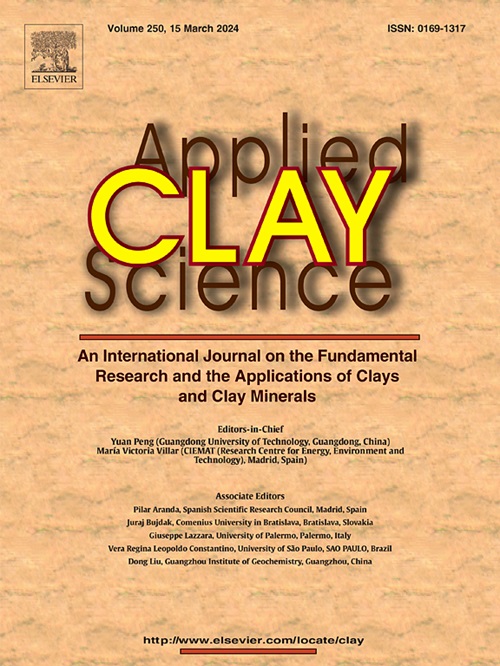干湿条件下蒙脱石层间阳离子的固定与释放
IF 5.8
2区 地球科学
Q2 CHEMISTRY, PHYSICAL
引用次数: 0
摘要
本研究的目的是研究蒙脱石在湿(水热实验)和干(烘箱加热)两种不同条件下长时间加热的层电荷(LC)的变化。了解蒙脱石在高温下的行为是至关重要的,例如,在高放射性废物储存设施的情况下,膨润土(富含蒙脱石的岩石)被计划用作屏障之一。将两种蒙脱石和一种贝德雷尔石以Mg2+、Ca2+、Fe2+和K+四种阳离子形式,在100或200℃下加热157天。此外,LC再生试验涉及阳离子交换和水热处理的烘箱干燥样品进行了。LC采用光谱学OD法测定,而x射线衍射则用于验证OD法检测到的变化。在干燥加热实验中,大多数样品的LC值在加热146天内保持稳定,除了Fe2+和Mg2+交换蒙脱土的LC值下降,这被解释为由于球内配合物的形成和/或这些阳离子渗透到八面体薄片中。水热实验后样品的LC值变化较大,可能与阳离子交换、溶解和再沉淀过程有关。Fe2+交换样品在200℃水热反应时,在蒙脱石膨胀时形成高岭石,K+交换样品在相同条件下反应形成塌缩夹层。阳离子交换和水热处理并不总是能成功地恢复样品的初始LC,但在100°C干燥的情况下,水热再水化反应是有效的。本文研究了在部分干燥和水饱和条件下,层间阳离子的固定和释放改变富蒙脱石膨润土核废料处理屏障性能的机理。在100°C干燥后可逆,在200°C阳离子固定后不可逆,符合膨润土暴露于放射性产生的热量的常见温度限制。本文章由计算机程序翻译,如有差异,请以英文原文为准。
Fixation and liberation of smectite interlayer cations under dry and wet conditions
The aim of the present study was to examine changes in the layer charge (LC) of smectite heated for an extended period of time under two contrasting conditions: wet (hydrothermal experiments) and dry (oven heating). Understanding smectite's behavior at elevated temperatures is crucial, e.g., in the case of high-level radioactive waste storage facilities, where bentonites (smectite-rich rocks) are planned to be used as one of the barriers. A set of two montmorillonites and one beidellite in four cationic forms, Mg2+, Ca2+, Fe2+, and K+, was heated at 100 or 200 °C for up to 157 days. In addition, LC regeneration tests involving cation exchange and hydrothermal treatment of oven-dried samples were performed. LC was measured using the spectroscopic OD method, whereas X-ray diffraction was used to verify the changes detected by the OD method. In the dry-heating experiments, most samples showed stable LC values up to 146 days of heating, except the LC decrease for Fe2+ and Mg2+-exchanged montmorillonite, which was interpreted as resulting from the formation of inner-sphere complexes and/or penetration of these cations into the octahedral sheet. The LC values of samples after hydrothermal experiments were more variable, possibly due to the cation exchange, and dissolution and reprecipitation processes. In the case of Fe2+-exchanged samples reacted hydrothermally at 200 °C, kaolinite was formed at the expanse of smectite, and collapsed interlayers formed in K+-exchanged samples reacted under the same conditions. Cation exchange and hydrothermal treatment were not always successful in restoring the initial LC of samples, however, hydrothermal rehydration reaction was efficient in the case of samples dried at 100 °C. The paper presents the mechanism of interlayer cations fixation and liberation, which change the properties of smectite-rich bentonite barriers for nuclear waste disposal under partially dry vs. water-saturated conditions. Reversible after drying at 100 °C and irreversible after 200 °C cation fixation match common temperature limits of bentonite exposure to radioactively-produced heat.
求助全文
通过发布文献求助,成功后即可免费获取论文全文。
去求助
来源期刊

Applied Clay Science
地学-矿物学
CiteScore
10.30
自引率
10.70%
发文量
289
审稿时长
39 days
期刊介绍:
Applied Clay Science aims to be an international journal attracting high quality scientific papers on clays and clay minerals, including research papers, reviews, and technical notes. The journal covers typical subjects of Fundamental and Applied Clay Science such as:
• Synthesis and purification
• Structural, crystallographic and mineralogical properties of clays and clay minerals
• Thermal properties of clays and clay minerals
• Physico-chemical properties including i) surface and interface properties; ii) thermodynamic properties; iii) mechanical properties
• Interaction with water, with polar and apolar molecules
• Colloidal properties and rheology
• Adsorption, Intercalation, Ionic exchange
• Genesis and deposits of clay minerals
• Geology and geochemistry of clays
• Modification of clays and clay minerals properties by thermal and physical treatments
• Modification by chemical treatments with organic and inorganic molecules(organoclays, pillared clays)
• Modification by biological microorganisms. etc...
 求助内容:
求助内容: 应助结果提醒方式:
应助结果提醒方式:


